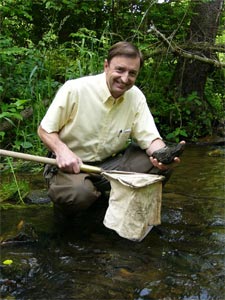Videos
Watch short interviews with individuals pursuing many facets of freshwater science and education. You can watch them all on our STEM Career playlist or watch individual videos below.
Aquatic Entomology
Fisheries and Microbiology
Systems Administration
Fluvial Geomorphology
Biogeochemistry
Field Instruction
Information Services
Watershed Management
Administration and Research
Citizen Science Project Manager
Education Director
Entomology Researcher
Interview With a Scientist: Bernard Sweeney, Ph.D.
 What are your research interests?
What are your research interests?
My research interests are:
- The role of streamside forests in the structure and function of stream and river ecosystems
- Factors affecting the growth and survivorship of trees in riparian forests
- The effects of global warming on stream ecosystems
- Population and community ecology of temperate and tropical aquatic invertebrates
- Factors affecting the growth and development of aquatic insects
- Pollution assessment in temperate and tropical streams using macroinvertebrates
- Genetic variation and gene flow among populations of stream insects
- Bioenergetics and secondary production of aquatic insects
- The bioassay of toxic materials in aquatic systems
How long have you been a scientist?
I have been a scientist since 1976. I graduated with a Bachelor of Science in biology from Delaware Valley College of Science and Agriculture in 1972 and a Ph.D. in Zoology from the University of Pennsylvania in 1976.
How did you become interested in science? What made you decide to study streams?
I initially majored in Biology as a pre-med student but, between my freshman and sophomore year of college, two things happened that turned my attention away from medicine and toward natural science and aquatic natural science in particular: (i) I took a summer field course involving the study of natural plant and animal populations which involved a section on stream ecology. This is where I learned to put names and meaning (what function they play in the environment) to the plants and critters that I had always admired during my youth; (ii) I had done well in my freshman classes and was offered a work-study research position for the department chair who happened to be an entomologist and connected with the mosquito control program (hence more aquatic science).
By my senior year, I had published a paper on mosquitoes and finished a senior research thesis on the effects of pollution on the caddisflies of streams in the local county where the college was located. Medical school was a faint memory and continuing research on stream and river ecology at the graduate school level was on the front burner.
How have you used leaf packs in your research projects?

Dr. Sweeney (left) and fellow scientists sample for macroinvertebrates.
When I arrived at Stroud Water Research Center in 1972, the Center had already pioneered the use of leaf packs for studying stream ecology two or three years earlier. I personally was involved in using leaf packs throughout the late 1970’s and early 80’s while we were trying to figure out how different species of leaves (as food) affected the growth and survivorship of various species of macroinvertebrates. I then used leaf packs for the first time as a water pollution tool in 1983 when I helped design a project for evaluating the effects of water flow fluctuations (random and drastic change in water levels), due to a nuclear reactor, on macroinvertebrate populations in Upper Three Runs, South Carolina. Another related project was assessing paper pulp effluent on macroinvertebrates in the Flint River, Georgia. Later, in 1989, I used leaf packs with my daughter’s 9th grade class to look at macroinvertebrate colonization on native and foreign species of leaves in the headwaters of White Clay Creek, PA. This was the beginning of leaf pack as an education tool. More recently (1990 – present), we are using leaf packs to study macroinvertebrate populations in tropical streams of Costa Rica.
What were some of the difficulties/problems you had with leaf pack placement in streams? (For example, did you ever lose packs/experiments?)
After losing many leaf packs, we quickly figured out that they needed to be either tethered tightly to bricks or logs on the stream bottom or staked directly to the bottom. Once we anchored them correctly, we rarely lost them unless we had a huge storm event.
What were some of the results you found with leaf packs?
We found that macroinvertebrates can distinguish the different species of leaves and that some definitely prefer to eat the species that they grow best on. We also found that species tend to remain in the leaf packs if they get dewatered, as the water level drops, and that the macroinvertebrate community that develops on leaf packs is quite useful for monitoring the health of the stream.
What advice would you give students interested in science?
Maintain a broad interest in all aspects of science even as you tend to specialize academically (in college) or in the job market. Take as many science courses as you can while in school, and force yourself to take the ones that you feel are least relevant to your career goals (e.g. do not avoid chemistry because you are a biology major). My experience is that you do not know where your career will take you and the broader your education base, the better.


